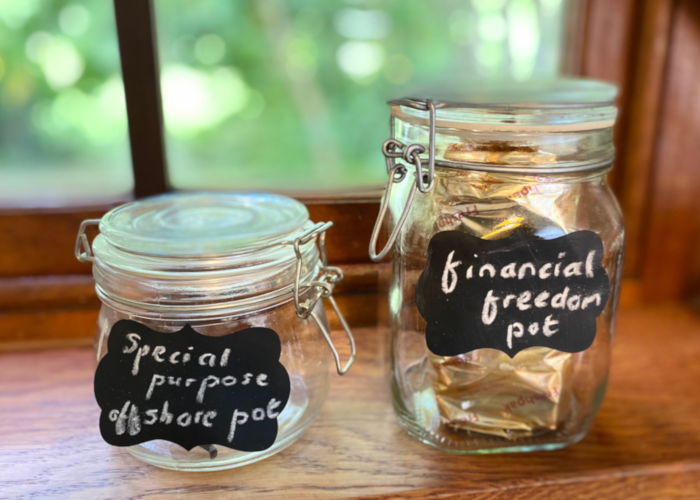How much should you invest offshore?
By Lizelle Steyn
2 February 2021

Photo credit: Gabby K
Over the past decade, offshore has been the place to invest for South Africans, if we compare global equity with local equity returns. But rolling your entire portfolio into a little bundle and taking it all overseas has several drawbacks. In a previous post I listed seven reasons why investing 100% offshore is a bad idea for most South Africans. If not all of it, then how much should you invest offshore?
Here are the most important questions to ask yourself:
Do you have any special offshore expenses waiting for you in your future?
Do you have an expense waiting somewhere in your future that you’ll need to settle in an offshore currency? It could be a child’s university education overseas (or your own). It could be a sabbatical that you’re planning to spend overseas, or an around-the-world trip. If you have anything like this for which you need to budget, you’ll need to create a special purpose offshore ‘pot’ in your mind and save and invest for this money first, separately from your general long-term financial freedom pot.
In most cases, combining this pot with your financial freedom pot is a bad idea as the two goals have different investment horizons and might need to be in separate accounts and funds with different risk profiles. If, for example, you’re saving for training in the US in two years’ time, that’s too short a term to invest in global equity ETFs (anything could happen to the markets over a period as short as two years.) In this example, you would need to save up the dollar amount to cover your costs in a dollar based low-risk short-term savings product.

For the rest of this post we focus on how much of your financial freedom pot you need to invest offshore – based on the principle of matching your assets with your future expenses.
What are the chances of you emigrating?
What are your chances of emigrating for tax purposes or spending most of your life overseas? Zero? 20% 50% Whatever this figure is, invest at least that percentage of your financial freedom pot offshore to make sure your investment keeps its value in a hard currency like dollar or euro. This will protect you against a scenario where you are saving diligently here in SA, but due to profound rand weakening, the sum that you are able to take with you one day ends up being worth not much in your new country of residence.
If you don’t emigrate, what percentage of your bills will originate overseas?
An important point to consider, even if you have no plans to emigrate, is how much of your time will be spent overseas and what percentage of your annual bills will relate to you being in another country?
As emigration for tax purposes triggers a huge capital gains tax event (it’s as if you sell all your worldwide assets on one day), I can see how more and more SA citizens who are able to work and live in other countries will choose to remain ‘ordinarily resident’ in SA but spend part of the year not based in SA. If offshore accommodation and living expenses will form a significant portion of your budget once you reach your financial freedom goals, you would need to increase the percentage of your offshore allocation.
How much do you spend every year on imported goods?
Even if you have no plans to emigrate and can’t see yourself living abroad for a few months every year, you’re guaranteed to have some future expenses tied to an offshore currency. Love coffee? Chances are almost 100% those beans are imported. Most vehicle parts in this country are also imported. Mainstream clothing lines? Imported. Cell phone, laptop, solar panels… The list of imported items that we enjoy on a daily basis is a very long one. Which is part of the reason why everybody should allocate at least some of their overall portfolio to offshore assets. In the formula below I’m assuming that you spend 10% of your annual expenses on imported goods. You are welcome to adjust this % for your personal budget.
A formula for how much you need to invest offshore
Looking at how you answered the previous 3 questions, you can use each answer to calculate one of the 3 components that make up your total offshore allocation %.
A - Possible emigration component = the % chance of you emigrating at some point in your future
B - Resident-but-roaming component = (% chance of you remaining an SA tax resident for the rest of your life) x (% of your bills which will be in another currency)
C - Imported goods component = (% chance of you remaining an SA tax resident for the rest of your life) x 10%
The % you need to invest offshore = Possible emigration component + Resident-but-roaming component + Imported goods component.
How to use the ‘how much offshore’ formula – an example
Let's use Yolisa as an example of how much to allocate offshore. Yolisa thinks there’s about a 20% chance of her ever emigrating. And therefore – for the maths to add up – there’s an 80% chance of her remaining an SA tax resident.
A - Possible emigration component = 0.2 = 20%
Should Yolisa remain an SA tax resident (80% chance) but use her financial freedom to live elsewhere for 3-4 months every year, she estimates that maximum 40% of her annual expenses could then be linked to another currency.
B - Resident-but-roaming component = 0.8 x 0.4 = 0.32 = 32%
Yolisa reckons she spends about 10% of her annual bills on imported goods.
C - Imported goods component = 0.8 x 0.1 = 0.08 = 8%
The % Yolisa needs to invest offshore = 20% + 32% + 8% = 60%
This is the maximum, not minimum, Yolisa needs to invest in another currency or an offshore-linked investment, for two reasons:
- She already has an allocation to SA equity, and more than half of SA companies’ earnings come from overseas. That’s a ‘hidden’ rand hedge (protection against a weakening rand) that’s already built into her SA portfolio without her having to invest money offshore.
- For her Resident-but-roaming component, she has emerging countries like Thailand in mind. In that case, the rand (also an emerging country currency) might be more closely correlated to the currency of that country than the dollar or euro currency of her chosen offshore ETF or mutual fund is correlated to it. In other words, a rand based investment might be able to keep up with her future expenses in Thai baht.
To clarify, 'investing offshore' doesn't mean necessarily taking your money out of the country; it also includes the more affordable route of investing in a global ETF or fund via a local platform, such as Easy Equities, Sygnia, Allan Gray or Ninety One, or the currency app Shyft.
Deciding how much to invest offshore is not an exact science
Aligning the geography of your assets with the geography of your future expenses is not the only way to answer the question of how much to invest offshore. There are other approaches, but the simplified ‘formula’ above gives me the highest degree of certainty that I’ll be able to meet the expenses I can envision now. Whatever approach you use, make sure you and your portfolio have valid passports to cross borders. Having options outside of South Africa is liberating and opens up all sorts of possibilities for your life. That’s after all what financial freedom is about.
Related blog posts

Why investing 100% offshore is not a great idea
24 January 2021
Yes, the JSE makes up less than 1% of the global stock market and you need exposure to other parts of the world, with more opportunities than can be found in SA. Yes, global equity markets have left our stock market returns eating their dust over the past decade. Yes, you should invest offshore. But 100%? I can think of at least seven reasons why investing 100% offshore is not such a great idea.

Asset allocation - the most powerful driver of portfolio performance
5 January 2021
The FIRE movement has become obsessed with choosing funds with the lowest fees. But are we forgetting the main driver of portfolio performance - asset allocation? 2020 has been an excellent example of how different asset allocation choices can lead to wildly different investment returns.

